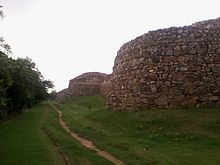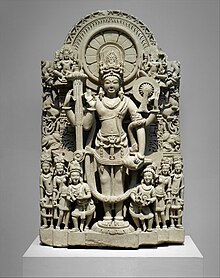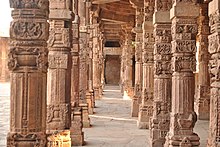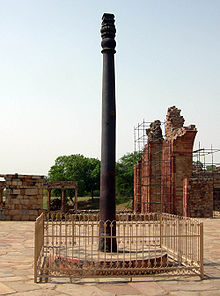
Tomar is a clan name, some members of which ruled parts of North India at different times. They are Rajputs and claim Chandravanshi descent.

Chauhan, a name derived from the historical Chahamanas, a clan name associated with various ruling Rajput families in the present-day Indian state of Rajasthan from seventh century onwards.

Lal Kot or Qila Rai Pithora is a fortified complex in present-day Delhi, which includes the Qutb Minar complex. It was constructed in the reign of Tomar Rajput king Anangpal Tomar between c. 1052 - c.1060 CE. It is termed as the "First city of Delhi". Remains of the fort walls are scattered across South Delhi, visible in present Saket, Mehrauli around Qutb complex, Sanjay Van, Kishangarh and Vasant Kunj areas.

The history of human settlement in the western Indian state of Rajasthan dates back to about 100,000 years ago. Around 5000 to 2000 BCE many regions of Rajasthan belonged as the site of the Indus Valley Civilization. Kalibangan is the main Indus site of Rajasthan, here fire altars have been discovered, similar to those found at Lothal.

Surajkund is an ancient reservoir of the 10th century located on Southern Delhi Ridge of Aravalli range in Faridabad city of Haryana state about 8 km from South Delhi. Surajkund is an artificial Kund built in the backdrop of the Aravalli hills with an amphitheatre shaped embankment constructed in semicircular form. It is said to have been built by the king Surajpal of the Tomara Rajputs in the 10th century. Tomar, a younger son of Anangpal Tomar – the Rajput ruler of Delhi, was a sun worshipper and he had therefore built a Sun temple on its western bank. Surajkund is known for its annual fair "Surajkund International Craft Mela", 2015 edition of this fair was visited by 1.2 million visitors including 160,000 foreigners with more than 20 countries participating in it.
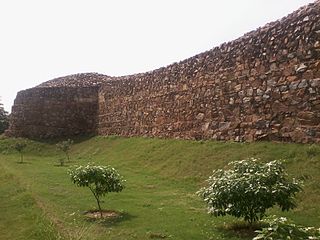
Anangpal II, popularly known as Anangpal Tomar, was an Indian ruler from the Tomara dynasty. He is known to have established and populated Delhi in the 11th century. He is often confused with Anangpal I, the founder of Tomar Dynasty of Delhi, who had reigned during the 8th century. He traced the lineage to Chandravanshi Kshatriya kings, namely Arjuna from the epic Mahabharata.

Asigarh Fort, also called Hansi Fort, is located on the eastern bank of Amti lake in Hansi city of Haryana, India, about 135 km from Delhi on NH9. Spread over 30 acres, in its prime days this fort used to be in control of 80 forts in the area around it. The fort is said to be one of the most impregnable forts of ancient India and has been declared a centrally protected monument by ASI in 1937.

The Kingdom of Ajmer was an early medieval kingdom in the Rajputana region of northwestern Indian subcontinent. It was ruled by the Chahamanas of Shakambhari, colloquially known as the Chauhans of Sambhar or Chauhans of Ajmer, the most prominent ruling family of the Chauhan Rajput clan. The territory ruled by them was known as Sapadalaksha.
The Chahamanas of Naddula, also known as the Chauhans of Nadol, were an Indian dynasty. They ruled the Marwar area around their capital Naddula between 10th and 12th centuries. They belonged to the Chahamana (Chauhan) clan of the Rajputs.
The Guhilas of Medapata colloquially known as Guhilas of Mewar were a Rajput dynasty that ruled the Kingdom of Mewar region in present-day Rajasthan state of India. The Guhila kings initially ruled as Gurjara-Pratihara feudatories between the end of 8th and 9th centuries and later were independent in period of the early 10th century and allied themselves with the Rashtrakutas. Their capitals included Nagahrada (Nagda) and Aghata (Ahar). For this reason, they are also known as the Nagda-Ahar branch of the Guhilas.
Samantaraja was an Indian king belonging to the Chahamana dynasty of Shakambhari. He ruled parts of present-day Rajasthan in north-western India.
Someshvara was an Indian king belonging to the Chahamana dynasty and ruled parts of present-day Rajasthan in north-western India. He was brought up at the Chaulukya court in Gujarat by his maternal relatives. After death of Prithviraja II, the Chahamana ministers brought him to the capital Ajmer and appointed him as the new king. He is said to have commissioned several Shiva temples in Ajmer, and is best known as the father of Prithviraja III.

Vigraharāja IV, also known as and also Visaladev was a king from the Chahamana (Chauhan) dynasty in north-western India, and is generally considered as one of the greatest rulers of the dynasty. He turned the Chahamana kingdom into an empire by subduing the neighbouring kingdoms of Chaulukya, Naddula, and Tomara kingdoms. He also repulsed Muslim invasions, from the Ghaznavid ruler Bahram Shah and defeated Khusrau Shah in Vigraharaja IV's first war against the Muslims.
Vigraharāja II was a king belonging to the Shakambhari Chahamana dynasty. He ruled the Sapadalaksha country, which included parts of present-day Rajasthan in north-western India.
Simharaja was an Indian king belonging to the Shakambhari Chahamana dynasty. He ruled the Sapadalaksha country, which included parts of present-day Rajasthan in north-western India. He was the first Chahamana ruler to assume the title Maharajadhiraja.
Vakpatiraja I, also known as Vappayaraja, was an Indian king belonging to the Shakambhari Chahamana dynasty. He ruled the Sapadalaksha country, which included parts of present-day Rajasthan in north-western India. He appears to have made an attempt to throw off the Gurjara-Pratihara overlordship, and was the first Chahamana king to assume the title Maharaja.
Jagaddeva was an Indian king belonging to the Shakambhari Chahamana dynasty. He ruled the Sapadalaksha country, which included parts of present-day Rajasthan in north-western India. He ascended the throne after killing his father Arnoraja, and ruled briefly before being dethroned by his brother Vigraharaja IV.
Arnoraja was an Indian king belonging to the Shakambhari Chahamana dynasty. He ruled the Sapadalaksha country, which included parts of present-day Rajasthan in north-western India. Arnoraja defeated the Ghaznavid king Bahram Shah in the Slaughter of Turushkas near Ajmer, and also defeated several neighbouring Hindu kings including the Paramaras and the Tomaras. He had to face defeats against the Chaulukyas, and was ultimately killed by his own son, Jagaddeva.
Alhana-deva was an Indian king belonging to the Naddula Chahamana dynasty. He ruled the area around Naddula, as a vassal of the Chaulukya king Kumarapala. During his reign, the Chahamanas of Shakambhari invaded Naddula, and Kumarapala replaced him with his own governors. Later, Kumarapala restored his rule in Naddula, as a result of his service in Chaulukya military campaigns.

Anangpur is a historical village located near Faridabad in Haryana, India. Anangpur forms a geographical triangle along with Mehrauli and Tugluqabad. It was the earliest settlement of the Tomaras. Anangpur was the capital of Anangpal Tomar who had built the fort and monuments here.
